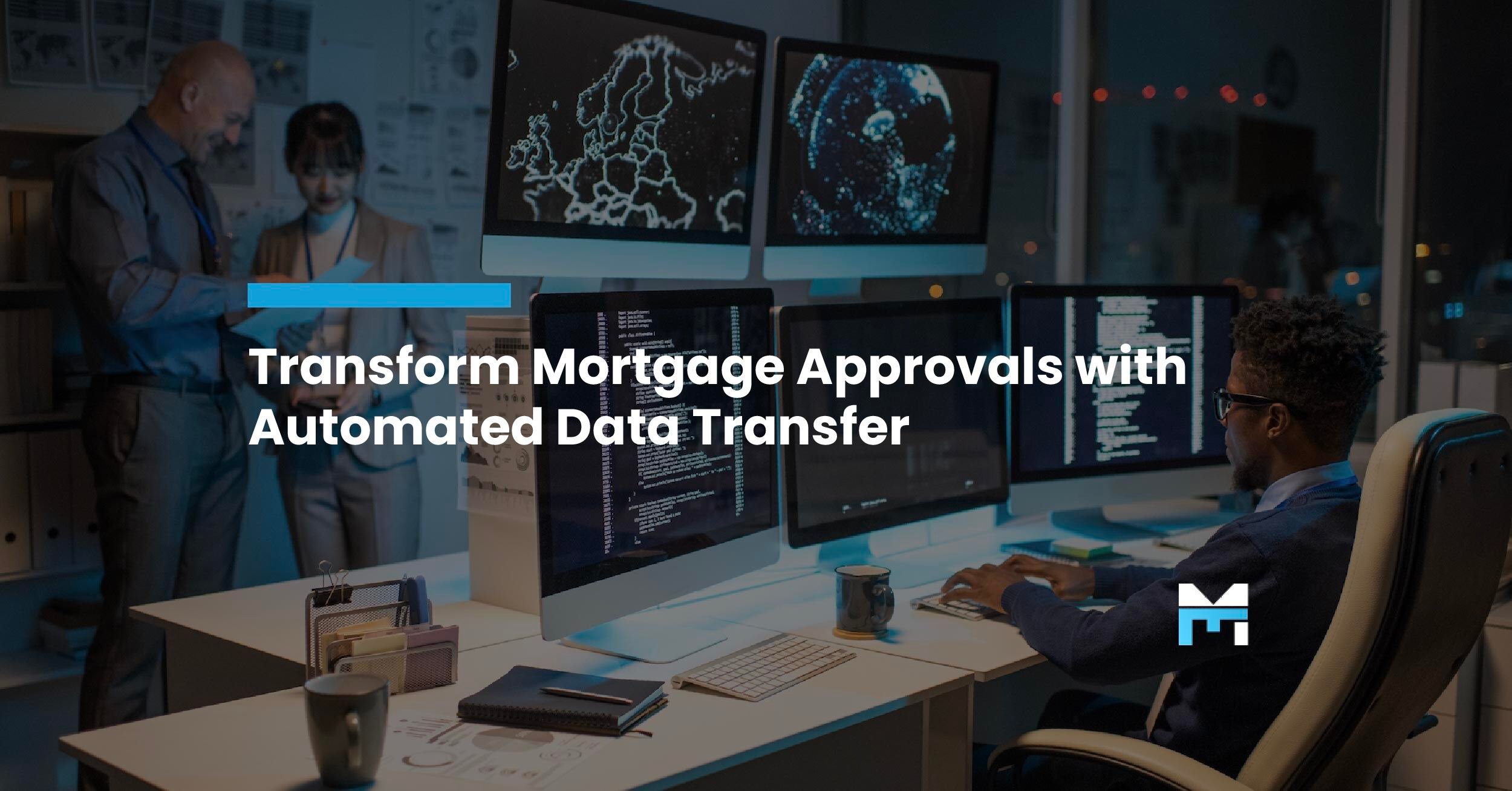The Mortgage Industry's Best Kept Secret: Automated Data Transfer for Faster Approvals
Think of the last time you submitted or processed a mortgage application. How long did it take to pull together the applicant’s financial data? Days?...
Information Security Compliance
Add security and compliance to Microsoft 365
BI Reporting Dashboards
Realtime pipeline insights to grow and refine your learning operation
Integrations for Banks & Credit Unions
Connect LOS, core platforms, and servicing system
Productivity Applications
Deploy customized desktop layouts for maximum efficiency
Server Hosting in Microsoft Azure
Protect your client and company data with BankGrade Security
10 min read
Justin Kirsch : Oct 14, 2025 10:00:00 AM

Remember when mortgage applications required a filing cabinet the size of a small car? Those days are officially extinct. The mortgage industry has undergone a digital metamorphosis that would make Darwin proud, transforming from paper-heavy processes to streamlined, AI-powered workflows that actually make sense.
The shift toward paperless operations isn't just about saving trees (though Mother Earth appreciates it). It's about survival in a market where borrowers expect Amazon-level convenience and lenders need lightning-fast processing to stay competitive. Modern technology and mortgage solutions are reshaping everything from initial applications to final closings, creating opportunities that were unimaginable just a decade ago.
This transformation affects every aspect of mortgage operations. Consider this: 92% of homebuyers now use online methods during their mortgage journey, with over one-third completing applications entirely online. The message is clear—adapt to digital or become a cautionary tale.
Paperless transformation isn’t an aesthetic choice, it’s a performance upgrade. When you remove manual document handling you don’t just save space; you recapture hours, reduce error, make compliance defensible, and materially change the economics of origination.
Use this as a conservative example to make the business case to partners.
Assumptions (example):
Per-loan labor savings:
Time saved per loan = 13.5 − 5 = 8.5 hours
Labor savings per loan = 8.5 × $70 = $595
Annual labor savings for 1,000 loans:
1,000 × $595 = $595,000
That’s a simple, conservative illustration showing how a modest reduction in document time produces a six-figure labor saving for a mid-volume lender. Swap in your own volumes, time savings, and rates, and you’ll have a partner-ready number in minutes.
Digital transformation delivers measurable results. Companies implementing comprehensive paperless solutions report fulfillment costs that are 35% lower than industry averages. Loan consultants become over three times more productive than industry medians when equipped with proper digital tools.
The math is straightforward: fewer manual tasks equal lower operational costs. Automated document processing eliminates redundant data entry, reduces staffing needs for basic administrative tasks, and minimizes the physical infrastructure required for paper storage and management.
Today's borrowers grew up with smartphones and expect digital-first experiences. They want to apply for mortgages the same way they order coffee…quickly, conveniently, and on their own terms. Paperless processes deliver exactly that.
Borrowers can complete applications from their kitchen table at midnight, upload documents via smartphone cameras, and track progress through user-friendly dashboards. This convenience translates directly into higher customer satisfaction scores and more referral business.
There was a time when e-signatures were used by a few and looked fancy when sent to the recipient. Now, paperless transformation isn’t an aesthetic choice; it’s a performance upgrade. When you remove manual document handling, you don’t just save space; you recapture hours, reduce error, make compliance defensible, and materially change the economics of origination.
At a minimum, pick a vendor that offers:
RON can eliminate in-person closings, but rules vary. Ensure your vendor:
AI turns document chaos into structured, validated data, but it’s not a single product you flip on. Think of it as a layered pipeline: ingestion → extraction → validation → human review → integration. When designed correctly, that pipeline transforms noisy inputs (phone photos, scanned PDFs, bank statements) into clean LOS-ready fields that speed underwriting and reduce rework.
Better.com deployed two AI systems that revolutionized their operations: Tinman handles initial underwriting processes autonomously, while Betsy serves as a 24/7 mortgage assistant. These systems work together to create a seamless borrower experience while dramatically reducing processing times.
Tinman completes entire initial underwriting processes without human intervention, eliminating traditional delays and approving loans faster than conventional methods. The system maintains consistency and accuracy that surpasses human-only processes.
nCino's AI-powered Doc Validation tool automatically classifies and validates common mortgage documents in seconds. The system routes files to appropriate loan origination system folders automatically and provides instant feedback when documents are incomplete or inaccurate.
This automation transforms document processing from a multi-hour manual task into an nearly instantaneous automated workflow, directly reducing per-loan processing costs and eliminating origination delays.
Modern fraud detection systems use machine learning to identify suspicious patterns in loan applications. These systems can flag unusual application behaviors, detect identity fraud indicators, and identify discrepancies linked to third-party tampering.
AI-powered fraud detection operates continuously, analyzing thousands of data points to identify risks that human reviewers might miss. This comprehensive approach protects lenders while ensuring legitimate borrowers aren't unnecessarily delayed.
Successful digital transformations begin with pilot programs rather than company-wide overhauls. Choose a single process (perhaps income verification or document collection) and implement digital solutions for that specific function.
This approach allows teams to learn new systems gradually while minimizing disruption to existing operations. Success in small implementations builds confidence and provides proof-of-concept for larger initiatives.
The best paperless solutions integrate seamlessly with existing loan origination systems. Look for platforms that work with your current Microsoft mortgage dashboard and other essential tools rather than requiring complete system replacements.
Unified systems ensure information flows smoothly between different processes, eliminating data silos, and reducing the risk of errors during information transfer.
Technology is only as effective as the people using it. Comprehensive training programs ensure team members understand new systems and feel comfortable with digital processes.
Change management strategies should address concerns about job security and workflow disruptions. Emphasize how automation eliminates tedious tasks, allowing employees to focus on higher-value activities that directly impact business success.
Microsoft mortgage dashboard solutions provide centralized platforms for managing entire loan pipelines. These dashboards integrate with existing Microsoft Office tools that teams already understand, reducing learning curves, and accelerating adoption.
Microsoft Power BI transforms raw loan data into actionable insights through interactive dashboards and customizable reports. Lenders can track key performance indicators (KPIs), identify trends, and make data-driven decisions with ease. By leveraging these visualizations, teams gain clearer perspectives on bottlenecks, loan statuses, and operational efficiencies, ensuring a more optimized workflow.
Microsoft mortgage dashboard solutions fluidly integrate with Microsoft Teams, fostering improved communication and collaboration across departments. Loan officers, underwriters, and processors can share updates, documents, and insights in real time, breaking down silos and boosting productivity. The ability to host virtual meetings and discussions directly within the platform ensures that critical decisions are made faster and with greater accuracy.
One of the key strengths of Microsoft mortgage dashboards lies in their flexibility. Users can customize workflows to match specific organizational needs, ensuring that systems adapt to the business, not the other way around. Automating repetitive tasks and tailoring approval processes reduces manual effort while maintaining compliance with regulatory standards.
By integrating Microsoft’s innovative vertical-specific tools, businesses can transform their mortgage processes, staying ahead of industry demands while driving greater efficiency and customer satisfaction.
One of the greatest barriers to adopting fresh, novel, evolved or otherwise new and/or previously unused solutions is the entrenched mindset of sticking to traditional methods that work. The "If It Ain’t Broke, Don’t Fix It" syndrome often stems from a fear of change, perceived complexity of having to learn new processes and/or systems, or an attachment to legacy processes. However, in today’s competitive landscape, clinging to outdated practices can hinder growth, efficiency, and customer satisfaction.
To overcome this resistance, businesses must prioritize a culture of adaptability and continuous improvement. Start by demonstrating the tangible benefits of change, such as simplified workflows, faster turnaround times, and improved compliance through automation. Engaging employees with hands-on training and illustrating real-world success stories further diminishes skepticism, fostering confidence in new approaches. By encouraging open communication, addressing concerns, and providing a clear roadmap for transitioning, organizations can smoothly shift from outdated processes to future-ready solutions, positioning themselves for long-term success.
To remain competitive in a rapidly evolving industry, mortgage businesses must prioritize future-proofing strategies that adapt to technological advances, regulatory shifts, and changing customer expectations. The implementation of scalable, cloud-based technologies can ensure operational flexibility while safeguarding sensitive data against potential threats. Additionally, leveraging analytics-driven insights allows businesses to better forecast market trends, optimize decision-making, and personalize client offerings for a superior customer experience.
Equally important is fostering a culture of continuous learning and innovation among employees. Providing access to professional development opportunities and staying ahead of emerging industry practices ensures your workforce remains skilled and adaptable, to the benefit of both the organization and the employees. By combining advanced technology with a forward-thinking approach, mortgage businesses can build resilience, maintain compliance, and meet the demands of a dynamic market. The focus on long-term sustainability positions your organization not just to survive but thrive in the competitive financial landscape.
Partnering with Mortgage Workspace as your managed service provider (MSP) positions your business to achieve unparalleled efficiency, adaptability, and security in the mortgage industry. By leveraging cutting-edge technology solutions, expert support, and tailored strategies, Mortgage Workspace ensures your organization is equipped to handle the complexities of today’s market while staying prepared for the challenges of tomorrow. Together, we can transform you business to optimize operations, enhance compliance, and deliver exceptional value to your clients, positioning you as a leader in the financial landscape.
Take the next step toward transforming your mortgage business today. Contact Mortgage Workspace to schedule a consultation and discover how our eco-friendly, sustainable solutions can empower your organization to excel in a competitive market. Together, we’ll redefine what’s possible; don’t wait, partner with us now to lead the future of the mortgage industry.

Think of the last time you submitted or processed a mortgage application. How long did it take to pull together the applicant’s financial data? Days?...

Efficient client communication is the backbone of success in the mortgage industry. Whether you're a loan officer helping a first-time buyer or a...
Are you struggling to keep tabs on your mortgage pipeline? With mortgage professionals juggling various tasks—from processing applications and...